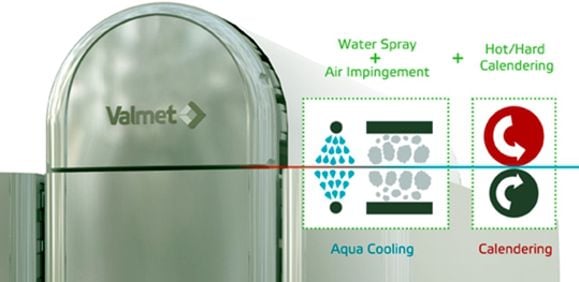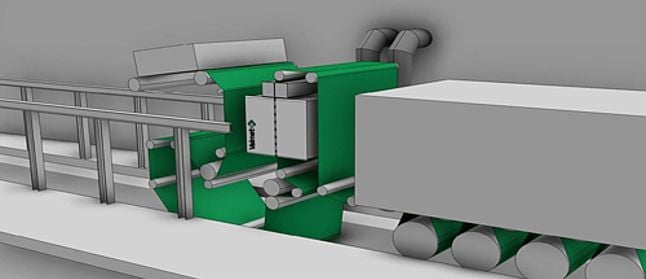Aqua cooling improves calendering results at Ingerois, case study
Valmet's new aqua cooling technology improves the calendering results compared to usual board mill production conditions by ideally conditioning the sheet via effective web cooling.
In most cases the best calendering results are achieved when the web is cool and stiff, such as found in pilot trials. With aqua cooling technology, the "ideal" conditions used in a pilot-type environment are realized at the production-level, by cooling down the web before the calendering nip. This is enabled by applying a small amount of water with a moisturizer, then evaporating it with an air impingement dryer.
Aqua cooling enables lightweighting
Aqua cooling calendering is aimed at making the end-product more lightweight, without compromising functional and visual properties. This "lightweighting" in turn generates a significant reduction in energy and raw material usage.
Aqua cooling calendering technology complements Valmet's bulk-saving metal belt calendering offering, as the ultimate lightweighting solution. Valmet has a pilot machine with aqua cooling technology and an OptiDry Chill web cooler available for customer trials.
A cool web recovers most of its original thickness when calendered. There is plastic deformation on the surface with elastic deformation in the core of the sheet. When temperature and/or moisture gradients are used to improve smoothness, the smoothness / bulk result is better than expected. Aqua cooling uses moisture before calendering to cool the web, thus presenting a cooler web to the calendering process. Basically this is the same process as experienced when your skin is wet and you walk into a windy environment - you feel colder than if your skin were dry, due to the evaporation process.

Aqua cooling uses moisture before calendering to cool the web before the calender.
With Aqua cooling technology, water is actively evaporated before the capillary absorption proceeds, in other words, within wetting delay time. Accordingly, fiber-to-fiber bonds of paper are not broken during the process of wetting, and web temperature decrease is effectively achieved with heat of vaporization drawn with air jet blows.
Water-spraying equipment with specially arranged nozzles are placed at a given interval in the cross direction, providing the necessary amount of water droplets on the web surface. And, within the short dwell time interval before the capillary absorption of the sprayed water starts and the water penetrates into the paper structure, the web is dried quickly with high speed air jets (PowerFloat Plus nozzles), which results in cooling the web with heat of vaporization drawn.
Benefits of aqua cooling include:
- Very effective cooling capability
- Substantial cooling can support a much higher load to reach a given bulk.
- Bulk can be improved at the target macro and micro smoothness. This can result in millions of dollars savings at a typical boxboard mill.
- Alternatively, smoothness can be improved at the target bulk.
- Significant production increase compared to the Yankee process
- Possible to increase speed as part of lightweighting
"Improving energy, water and raw material efficiency are the key targets in Valmet's research and development work. Our innovation in aqua cooling calendering technology is a good example of how we can improve the customer's product quality and raw material efficiency. With aqua cooling calendering technology it is possible to get almost half of the metal belt calendering benefits with significantly lower investment costs," says Mika Viljanmaa, Calendering Technology Development Manager from Valmet and 2012 Marcus Wallenberg Prize winner for his ground-breaking development of metal belt calendering technology.
First delivery to Stora Enso's Ingerois mill in Finland achieving results
Stora Enso decided to invest in this new aqua cooling calendering technology at their BM 4 packaging board machine in Ingerois, Finland. The target of the rebuild is to improve board quality, while also increasing bulk saving potential. In order to do this, Stora Enso decided to modernize the precalender of its board machine BM 4 to improve the quality of the produced board and lighten the board - i.e. increase its bulk - without compromising its properties. The rebuild includes new web moisturizing and evaporation cooling equipment. The rebuilt production line started up late 2015.

Aqua cooler installed just before the precalender of board machine.
Good cooperation and results
The new aqua cooling technology been successfully used in production. The technology has made it possible to lower the basis weight of the end product at BM 4 while maintaining the functional and visual properties of the board.
"The new aqua cooling technology enables developing and optimizing the machine's operating method to achieve bulk saving potential. This brings significant energy and raw material savings throughout the value chain of the product," said Taisto Nevalainen, Mill Director of Stora Enso's Ingerois Board Mill.
"Cooperation with Stora Enso was excellent from the very first contact to the start-up and the whole process was exceptionally fast. Using the new aqua cooling equipment in practice has confirmed the earlier results from our pilot machine. Installation of the equipment itself went well, and thanks to its compact structure, the equipment fits in perfectly despite the narrow space available," says Mika Viljanmaa.
Stora Enso is a leading provider of renewable solutions in packaging, biomaterials, wood and paper on global markets. Stora Enso's aim is to replace non-renewable materials by innovating and developing new products and services based on wood and other renewable materials. Stora Enso employs some 27,000 people in more than 35 countries, and the sales in 2014 were EUR 10.2 billion. Stora Enso shares are listed on Nasdaq Helsinki and Stockholm. The Ingerois Mill produces high-quality folding boxboard for consumer packaging needs such as food, confectionery and pharmaceutical products.